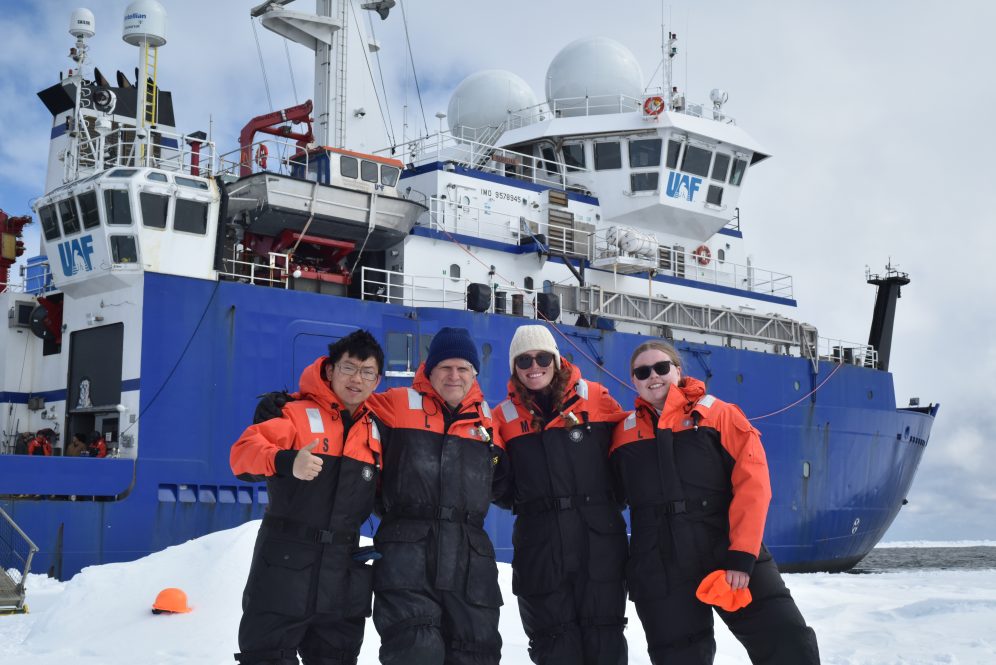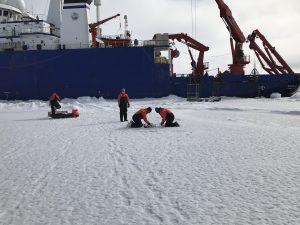Researchers tackle a previously unexplored aspect of mercury at the air-sea interface

Mason and his team standing outside of the research vessel Sikuliaq. The scientists on the research cruise took turns leaving the ship to take samples, as long as the coast was clear of polar bears. (Contributed photo)
Mercury (Hg) is a naturally occurring element found across the globe, yet it becomes highly toxic as it accumulates up the food chain. Pollution from human activities has pumped increasing amounts of mercury into the atmosphere, and for reasons that are not well understood, the Arctic region has significantly higher levels of mercury, despite having a relatively sparse population and less pollution.
Mercury is found in the environment as both inorganic and organic compounds, such as monomethylmercury (MMHg), which is the most bioavailable form of mercury that enters the food web and accumulates to toxic levels in wildlife and humans. Most people are exposed to MMHg from seafood consumption, but in the Arctic, people are at higher risk due to the consumption of marine mammals. Climate change also impacts Hg in polar regions, especially the increased melting of ice and glaciers, bringing changing inputs of Hg to the marine waters.
To examine the cycling of Hg in the Arctic, a team of researchers, including UConn Department of Marine Science Professor Robert Mason and his students, Yipeng He and Hannah Inman, developed a study focused at the air-sea interface to answer questions about why mercury (Hg) levels are higher in the Arctic. Their findings from a research expedition in spring 2021 are published in Science Advances.
One focus of the study was another organic form of Hg, dimethylmercury (DMHg), which is also very toxic, says Mason, and is found predominantly in deeper ocean waters but can cycle to the surface through upwelling of these waters. DMHg doesn't accumulate to the same degree as MMHg in the food chain as it's a dissolved gas in water. Another focus was MMHg, which can also be found in the atmosphere attached to aerosols or in precipitation and the source of this MMHg is highly debated.

Mason says some have wondered if this MMHg is the result of reactions taking place in the precipitation or in the atmosphere. Earlier studies found higher concentrations of mercury off the coast of California in cloud water and speculated about its sources so Mason says he and his research team were interested in focusing on the exchange of MMHg and DMHg at the sea-air interface in the Arctic to see if they could study these puzzling aspects of mercury cycling in more detail, specifically if DMHg originating from the upwelling of deep-sea waters in this area plays a critical role in how much MMHg ends up in the Arctic Ocean waters and in marine organisms.
"Dimethylmercury can be lost from the ocean if it's at high concentrations in the surface waters. The idea put forward was that in California, there must be an upwelling of deep ocean water to the surface that brings the dimethylmercury to the surface. However, no one had put all the bits together in one study," Mason says.
This is the first study to make all of the measurements in the atmosphere and seawater at the same time to piece together this dynamic puzzle and emphasizes the impacts DMHg can play in ecosystems far from the source.
Mason says a key aspect of this research that enabled them to assemble the clues was the ability to take constant measurements of the forms of Hg in the atmosphere and surface waters while aboard a research cruise, and taking advantage of a new instrument his research group developed that allows for continuous, high-resolution collection of DMHg while the ship is moving.
"Most research ships have a way of bringing surface water into the ship to measure the temperature, salinity, nutrients, and other chemicals. We developed an DMHg analyzer that could take a measurement every hour, and that was something no one had been able to do previously," he says.
The sampling took place aboard the research vessel Sikuliaq, which set off from Dutch Harbor, Alaska into the Bering and Chukchi Seas as far north as the ship could go because of ice, and then returned back to Seward, Alaska. Weather conditions and aspects of the landscape, such as permafrost, and the seascape, such as glaciers and sea ice impact mercury's movement through Arctic ecosystems, and its transport from the atmosphere and terrestrial environment to the marine waters. On the return trip, the ship encountered upwelled waters off the coast of the Aleutian Islands. Here, the researchers found high concentrations of DMHg. Mason explains that DMHg is unstable in sunlight and is degraded to MMHg in surface waters.
"Basically, the rate at which DMHg is coming up from the deep ocean to the surface has to be greater than the rate at which it's being decomposed for it to escape to the atmosphere," says Mason. "We took measurements of it and MMHg in the surface water, in the rain, and in the aerosols and found very high concentrations close to the source. Further north there was no more upwelling and the surface water sampled would have been sitting there since the ice retreated. Given that we were there in May and June, and we were following the retreating ice, the surface water is fresher because of the melting ice, and there's very little mixing of that water because of density differences."
The cruise navigated through relatively shallow water and about 15 miles into ice, which Mason said was around a meter thick. As long as the coast was clear of polar bears, the researchers took turns leaving the ship to collect samples. Mason and his team collected samples from the water, the surface snow on top of the ice, and the ice. They tested the samples for MMHg and found the snow contained significantly higher concentrations than the ice.
"The higher concentrations in this surface snow, which had been recently deposited on the ice, demonstrates the removal of methylmercury from the atmosphere, and that's part of the story of why we saw decreasing concentrations away from the source," says Mason.
They determined the DMHg is coming out of the ocean, is transported north, and then degraded in the atmosphere to MMHg. This MMHg is then attached to the aerosol particles and removed by precipitation.
"Our study showed that the amount of DMHg evaded to the atmosphere from the upwelling region was enough to account for the MMHg in the precipitation and aerosols over thousands of kilometers from the source," says Mason.
He explains that this makes it a complicated story, and is what has been the focus of much of his research on the exchange of Hg between the ocean and the atmosphere.
"In addition to DMHg, elemental Hg is also a dissolved gas in water and its loss to the atmosphere is a major removal mechanism for ocean Hg. Inorganic Hg comes into the ocean from the atmosphere primarily, although in the Arctic coastal inputs from rivers, glaciers and groundwater are more important than other oceans," says Mason. "Overall, Hg is moving back and forth all the time between the ocean and the atmosphere and the net input of inorganic Hg and MMHg is what controls the amount of MMHg in ocean waters and its bioaccumulation into organisms consumed by humans and wildlife."






